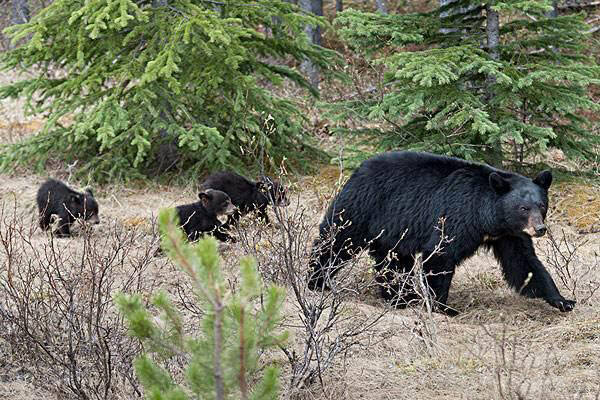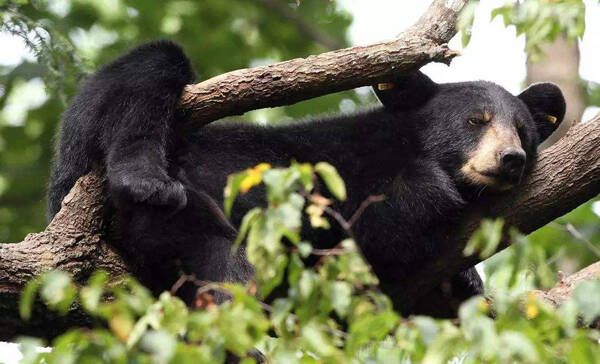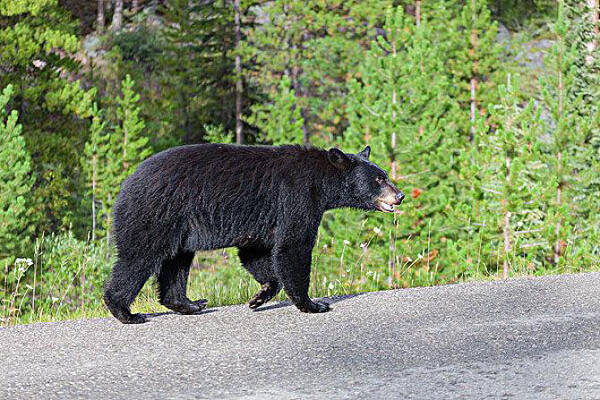Ursus americanus,
IUCN
LCBasic Information
Scientific classification
- name:Ursus americanus,
- Scientific Name:Ursus americanus,American Black Bear,North American black bear
- Outline:Carnivora
- Family:Ursidae Ursinae Ursus
Vital signs
- length:120-220cm
- Weight:40-272kg
- lifetime:25-32years
Feature
It is the largest bear in existence and ranks third in size among bears, smaller than polar bears and brown bears.
Distribution and Habitat
The distribution range extends from southern Alaska to the east across Canada to Newfoundland and Labrador on the east coast; to the south through parts of the United States, all the way to Nayarit and Tamaulipas in northern Mexico, including 39 states in the United States and all provinces in Canada except Prince Edward Island, mainly living in various national parks and mountain areas in North America.
The American black bear mainly inhabits coniferous forests and deciduous broad-leaved forests and woodlands, but it is very adaptable and can also live in dry Mexican shrubs, Louisiana swamps, Alaskan temperate rainforests and Labrador tundra. This species lives at an altitude range from sea level to up to 3,500 meters above sea level. In the east, it is mainly found in forests and swamps. In the west, it is mostly found in forests and wooded mountains. It likes to live in forests and shrubs, such as wet grasslands, mountain tops, burned areas, riverbanks and landslide slopes. It al
Appearance
There are 16 subspecies of American black bears. The body length is 1.2-2.2 meters, the shoulder height is 0.7-1.1 meters, the weight of males is 60-272 kg, and the weight of females is 40-150 kg. Males are 30% to 40% larger than females. It has stubby limbs, a huge body, small eyes, round ears, a long nose, and a short tail. Able to stand and walk on only hind limbs, but generally on all fours. Because the soles of its feet are flat, it walks slowly, and its hind limbs are slightly longer than its forelimbs. Both the front and rear limbs have 5 toes, which are plantar and walk with the entire sole of the foot touching the ground. Their palms have five strong claws used for tearing, digging and climbing. The power of the forepaw is enough to kill an adult red deer.
American black bears have thick hair and sometimes have white V-shaped chest spots on their chests. There are many kinds of body colors of American black bears. Most black bears are black or light brown, but their coat co
Details
American black bear (scientific name: Ursus americanus) is a large bear with 16 subspecies.

American black bears are solitary animals. Their activity time varies depending on where they live and the season. In spring, they often go out to look for food at dawn or dusk, and in summer they spend a lot of time active during the day. In autumn, they come out to look for food and wander around day and night. The American black bear usually moves slowly and clumsily, but when chasing prey or encountering danger, they will run at a very fast speed, climb trees and swim.
American black bears are very good at climbing trees, which is quite effective when avoiding enemies. Although they are more aggressive, they will try to avoid unnecessary fights to avoid hurting themselves. They often use visual intimidation to scare off the opponent, such as standing up with their teeth and claws bared, baring their teeth at the opponent, and making an attacking gesture. Most fights occur during the mating season. In order to compete for reproductive rights, male bears have to resort to force. In addition, in order to force single mothers who raise children to enter the estrus period as soon as possible, male bears will kill the children of female bears. In order to protect their children, mother bears are always very careful. Lactating mother bears will lead their cubs to avoid adult male bears as much as possible. The territory patrolled by mother bears is not as large as that of male bears. If they are unfortunate enough to encounter a dangerous male bear, they will fight with all their strength. Despite this, 70% of the deaths of cubs are caused by male bears.
American black bears are very territorial animals, and their territory is also very wide. The territory of a mother bear is about 3-40 square kilometers, while that of a male bear is 20-100 square kilometers. Since the territory of a male bear is much larger than that of a mother bear, its territory often intersects with the territories of different mother bears, but it will not overlap with the same sex. Young female bears who have just become independent may simply establish their own territory within their mother's territory in the first few years. But those little male bears will be driven away by their mothers. In addition, the abundance of food and the density of bears will also cause the size of their territory to change from time to time.

American black bears are omnivorous animals with a wide range of food, but their main food is plant-based. 95% of its food is grass, herbs, fruits and tree fruits, seeds, fungi, nuts, mushrooms, bamboo shoots, sweet potatoes, pine seeds, acorns and various berries. It also eats insects, fish, frogs, bird eggs and small mammals. It likes to dig ant nests and honeycombs. The black bear population living in Labrador, USA, mainly hunts small mammals and reindeer. Black bears living near the coast or river will use fish and crustaceans as their main food; black bears living in northern Canada will spend a lot of time catching lemmings; and in Alaska, black bears there will catch abundant salmon and local deer. Because human settlements are close to the survival range of this species, human garbage is an important food source for black bears living near human cities; they will choose to look for food including human garbage, poultry feed, agricultural products and honey bee farms.
American black bears change their diet with different seasons. In the spring, black bears choose carrion and plant food, and they also catch some small game to replenish the fat consumed in the winter. In the summer, they eat a lot of berries, and catch some rodents and other small prey to supplement their nutrition. In the fall, all kinds of ripe and delicious berries, fruits and nuts are everywhere, allowing them to enjoy them. In late fall and early winter, they have to step up their eating because the food-scarce winter is coming, and they have to prepare for the future hibernation.
In the northern part of the Americas where they are distributed, American black bears have an annual hibernation period of up to 7 months, during which the fat in the black bears' bodies is stored and their body temperature and heart rate are lowered to save energy. In the warm southern regions, this species generally hibernates for a shorter period of time and their physical signs remain relatively active. Some southern black bears even have no hibernation period throughout the year. Although pregnant females always build a den to spend the winter, give birth and care for their cubs, dens in the north are usually built underground or in a hole dug in the snow and ice, while dens in southern regions can also be built in trees.
The breeding season of American black bears is between June and July. The fertilized egg does not develop after being implanted in the female's uterus, and it is delayed until November, when the female bear begins to grow during hibernation. Pregnant female bears will burrow into the den to hibernate after storing enough fat. After ten weeks of rapid development, cubs are usually born in January or February of the following year. Each litter usually has 2-3 cubs, and twins are common. When the cubs are born, they weigh only 225-330 grams, are hairless, and cannot see clearly at birth. They can neither see nor hear. Due to the rich nutrition of breast milk, the cubs grow very fast. When they leave the den in spring, they weigh 2-5 kilograms. After the spring warms up, black bears begin to leave the den. The cubs are not yet weaned. They are full of energy, curious and like to play. When their mothers sense danger, they will tell the cubs to climb up the trees. The cubs are usually weaned at 6-8 months in the first year. The cubs will live with their mothers for about a year and a half. In the winter of the second year, they will live independently. At this time, the mother bear enters the estrus period again and usually forces the children out of her territory in order to give birth to offspring again. The survival of the cubs depends entirely on the skills taught by the mother bear, how to find food, find caves, and when and where to find shelter to keep warm and avoid danger. During the breeding season, female bears usually take the cubs away from the tribe to avoid male bears from harming the cubs. Females mature at four to five years old, while males can reach sexual maturity at one year old.
The cubs that leave their mothers usually weigh only 7-49 kg, depending on the abundance of food. Female bears reach sexual maturity between 2 and 9 years old, and male bears reach sexual maturity at around 3 to 4 years old. Male bears continue to grow in size before the age of 10 to 12. The average lifespan of an American black bear in nature is 25 years, and the longest can live to 32 years old.

American black bears are a hunting species and are well controlled by legal hunting plans formulated by relevant national and provincial agencies. In the 12 provinces and territories of Canada where they live, and in 28 or 29 states in the United States (New Jersey allows hunting depending on the situation each year), the total number of this species in Canada and the United States is controlled at between 40,000 and 50,000 per year. The license required to hunt black bears in Mexico is more stringent.
Listed in the 2008 Red List of Endangered Species of the World Conservation Union (IUCN) ver 3.1 - Least Concern (LC).
Protect wild animals and eliminate game.
Maintaining ecological balance is everyone's responsibility!








